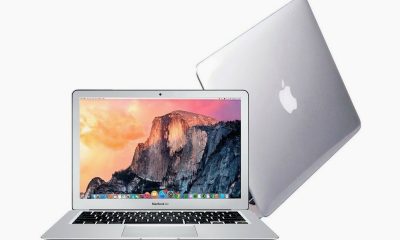Make Money
15 Best Money Apps For Teens (Investing, Budgeting and More)

Do you want to teach your teen how to manage money? If so, the best money apps for teens can help.
Prices and features differ for each option, but all money apps aim to help you and your child better manage their money.
We found the most popular money apps for teens, evaluated what they offer and determined how they can help your teen improve their finances.
Best Investing Apps for Teens
There are some apps for teens that are focused on investing. Although each app may have multiple features, we’re sharing how the investing portion of the app works.
1. Acorns Early
Acorns is a mobile banking app that costs $3 per month for a personal account and $5 per month for a family account.
With your Acorns account, you get your own personal banking and spending account. You also get a savings account and an investment account.
When you upgrade to the Family account, you can open Uniform Transfers to Minor Act/Uniform Gifts to Minor Act (UTMA/UGMA) investment accounts for each of your children at no extra cost.
All funds invested with Acorns go into one of five ETF portfolios. These portfolios have varying levels of risk, ranging from conservative to aggressive.
Funds deposited into kids’ accounts automatically go into the most aggressive Acorns ETF (100% stocks) for maximum growth potential.
The minimum investment is just $5 per month. As a parent, you can transfer the account to your child when they reach your state’s legal age.
Price: $5 per month
Pros: Affordable monthly contributions, multiple kids’ accounts for one price
Cons: Monthly fee, no tax loss harvesting
Learn more: Acorns Review: Is Acorns Worth It To Invest Your Spare Change?
2. EarlyBird
EarlyBird is a UGMA account that helps your child invest for college or any other future expenses.
Like Acorns, EarlyBird has five ETF portfolio funds you can choose from, from conservative to aggressive.
Unlike Acorns, EarlyBird allows you to choose the mix of portfolios you can invest in for your child. You’ll pay $2.95 per month to invest if you open an account for just one child.
If you add more children later, the price goes up to $4.95 per month. Another nice thing about the EarlyBird account is that you get a custom link you can share with others.
Send the link to grandparents, uncles, aunts, friends and more so they can help build your child’s investment account.
Price: $2.95 or $4.95 per month
Pros: Choose from five different investment portfolios, share the link for others to contribute
Cons: No other services are offered
3. Fidelity Youth Account
Popular brokerage firm Fidelity offers a Youth account for kids to start investing. The account has no minimums, no monthly fees and is not a custodial account.
The Fidelity Youth account allows your child to invest in most NMS securities, including fractional shares of stocks, Fidelity mutual funds and more.
Keep in mind that this account belongs solely to your minor child. As such, you will have limited parental control, but you’ll be able to view activities and statements.
You are listed as an Interested Party and as the trusted contact on the account. However, you won’t have any joint ownership or other authoritative designations.
Price: Free
Pros: Invest with no trading fees, spending/savings accounts included, fractional shares available
Cons: Parents must have a Fidelity account in order to open a Youth account
4. Greenlight App
Greenlight is an app that helps kids learn to earn, save, spend and invest. The app offers three plans.
These include:
However, only the Max and Infinity plans allow kids to invest. You won’t pay any trading fees with Greenlight.
Additionally, your child can invest in fractional shares of stocks and mutual funds with as little as $1. Unlike Fidelity’s Youth account, the Greenlight investment account calls for parental approval for every attempted trade.
As the parent and owner of the account, you can also help define a growth strategy for your child and create the risk portfolio that works best for your child and family.
Although this app is priced higher than other investment apps, you may find the additional features worth the cost.
Price: $9.98 to $14.98 per month
Pros: Earn, spend, save and give features included
Cons: Higher priced than other available investment apps for kids
5. UNest
UNest provides a UTMA/UGMA account that holds funds that can be used for college, a down payment for a house or any other savings goal you have for your child.
The app allows for investment in up to nine different portfolios, from conservative to aggressive. You can even invest in some cryptocurrencies for your child, although you may get charged a fee from the clearing house (APEX) to do so.
As with other apps mentioned here, UNest does allow family and friends to add to your child’s investment via a custom link.
You can earn additional investment funds for your child’s account when you use UNest Rewards and take advantage of the special offers within the app.
Price: $4.99 per month
Pros: Fee includes unlimited child accounts, expansive choice of portfolios to choose from
Cons: Minimum contribution requirement of $25 per month
6. Webull
Although Webull is only available for teens ages 18 and 19, we thought it was worth mentioning for two reasons. This app offers zero commissions and a helpful stock simulator tool.
If you want to encourage your teen to go totally independent with their investing or get some practice by using a stock simulator, you might prefer to use Webull.
Use Webull to trade stocks, ETFs, crypto and more. Better yet, as of July 2021, Webull allows for fractional trading as well.
Price: Free
Pros: Stock simulator tool available
Cons: Only for teens ages 18 and 19
Learn more: Webull Review: Is This Investing App Worth It?
Best Budgeting Apps for Teens
If you just want your teens to learn the basics of budgeting, there are apps out there that can help. These are the top budgeting apps for teens.
7. Current
Current gives kids the chance to learn how to earn, spend and save their money. The account comes with a debit card, savings pods and tools to help teens learn how to manage money well.
Parental controls allow for real-time activity notifications, merchant blocking and spending limits.
The debit card from Current has many safety features, such as EMV chips, privacy controls and more. Parents and teens alike can be confident that their money is secure with this app.
Price: $36 per year
Pros: Debit card purchase roundups, attractive parent control features
Cons: Limited investment features
8. Copper Card
Copper is a banking app that offers up to five teen or child accounts when parents open an account. Learning tools, including budgeting, are available.
As a parent, you can send money instantly to your child’s account or automate allowance. Teens can also set up direct deposit to their Copper account.
Teens can take advantage of financial literacy lessons, earn bonus cash and more.
Price: No monthly fees
Pros: Investing accounts for kids ages six and up
Cons: Card reload fees and instant transfer fees from some accounts
Learn more: Copper Banking Review: Is This Bank Account for Teens Worth It?
9. FamZoo
FamZoo is a family-friendly app that includes earning, saving and spending options for teens and kids.
Money earned is placed in an account that your teen accesses via a prepaid spending card. Teens can also set goals for saving and giving. Plus, they can place money in a savings pod.
Chores assigned to more than one child are “stealable,” teaching kids that the early bird gets the worm. Basic budget sheets are available with this app.
Price: $2.50 per month to $5.99 per month
Pros: Stealable chores, budget sheets, family loan option and chore penalty options
Cons: No investment feature
Learn more: FamZoo Review: Is This Prepaid Debit Card Worth It?
10. Fidelity Youth Account
Although the Fidelity Youth account is meant primarily for investing, the app does have a savings account to hold funds in.
In addition, the app offers a host of financial literacy tools that can help your teen learn to budget, manage debt and more.
Get this app if you want your teen to learn budgeting and other financial tips while focusing heavily on investing.
Price: Free with a parent account
Pros: Savings, investing and financial literacy tools
Cons: No spending card
11. GoHenry
GoHenry is a money app that helps parents teach kids to earn money and more. As a parent, you can give your kids regular allowances through the app or assign chores they’ll get paid for upon completion.
You can also give one-off transfers to your kid or teen at any time. Parental controls include real-time activity notifications and card lock/unlock capabilities.
Spending, giving and sending money to friends are also included features with this app.
Price: $4.99 per month
Pros: Age-appropriate learning videos and quizzes
Cons: No investing option
Learn more: GoHenry Card Review: Is It a Good Debit Card Option for Teens?
12. Greenlight App
Greenlight offers a comprehensive app that can help kids and teens create a budget that lets them earn, save, spend and give as they wish.
For just $4.99 per month, your teen can learn how to earn and manage money, complete with parental controls that can set spending limits, lock/unlock the included debit card and more.
Upgrade to one of the two higher-priced plans to go beyond budgeting and learn about investing and more.
Price: $4.99 per month up to $14.98 per month
Pros: Savings bonuses and comprehensive tools are included in all plans
Cons: Upgrade to a higher plan to have investing
Learn more: Greenlight Review: Is This a Good Debit Card for Kids?
13. Step
Step is a Visa card that allows your kids to use it to spend whatever money is stored in their Step account.
Since they can only spend up to the amount of money in the account, Step helps your child learn to budget.
Step also reports all payments to the card as on-time credit payments, helping children of all ages begin to build credit.
Price: Free
Pros: Build credit, create and fund savings goals, purchase roundups
Cons: No investing option
Best Chore Apps for Teens
For parents looking for an app that can help with teen chore management, these options are worth checking out.
14. Homey
Homey is a chore app designed to help track chores and reward kids for completing tasks. Although the app doesn’t have a spending card, it does help you track money earned and create/achieve savings goals.
Basic Homey allows for three accounts, while Premium Homey allows for unlimited accounts.
Price: Free for Basic, $4.99 per month or $49.99 annually for Premium
Pros: Unlimited savings jars and chore approval with a Premium account
Cons: Limited features with a Basic account
15. OurHome
OurHome is a chore app that rewards teens and kids on a points basis. You, as the parent, assign chores and reward kids with points for each completed chore.
The app allows you to add rewards to your account, including the number of points needed to earn a reward. Kids can then use their app to claim a reward.
Price: Free
Pros: Points-based system allows for a variety of rewards
Cons: No banking feature
Methodology
When evaluating different money apps for teens, there were key factors we analyzed to determine the best options in the space. In-depth research was performed to identify the top competitors that help teens with their finances.
We focused on the following criteria:
- Apple App Store rating of 4.0 or higher
- Reputation among industry leaders
- Ease of use
- Low or no fees
We chose this methodology to ensure we’re doing our due diligence as we determined the best apps like OfferUp.
How to Choose the Best Finance App
Choosing the best finance app for your teen is simply a matter of determining which app best fits your needs and budget.
But how do you do that? Researching and comparing options is important. Make a list of each app, what they offer, what they cost and what reviews say on reputable sites like Trustpilot.
Then choose the app(s) that best meet your criteria.
Financial Planning for Teens and Adults
Good financial planning and management can often seem elusive, but it’s a necessity if you want to have a peaceful life from a monetary standpoint.
Here are some quick tips for both teens and adults to manage their money in a way that will prepare them for a secure financial future.
1. Know Your Goals
Knowing your financial goals is critical to good financial planning. Take some time to sit down and make a list of short (less than one year), medium (one to five years) and long-term (over five years) financial goals.
2. Discover Value-Based Spending
Value-based spending is a budgeting tool that can work wonders when it comes to money management.
By simply taking the time to weigh purchase decisions based on how much time it takes to earn money for it and in the context of deviating from saving for other goals, you can decide whether a purchase will bring value to your life or not.
3. Find a Budget That Works for You
Every person’s budget will work differently. This is because everyone has different expenses and different priorities.
Your job is to create a budget that works for your situation and keep tweaking it as needed to help you reach your goals.
4. Establish an Emergency Fund
Having an emergency fund will save you from unnecessary stress. An emergency fund helps make money less of a factor when it comes to important decisions.
Aim to save three to six months’ worth of expenses in your emergency fund. Add to it as you can while managing your budget.
5. Educate Yourself on Investing
Whether you’re just beginning to invest or are a pro, educating yourself on investing is important. Use the advice of experts such as Jim Collins and Warren Buffett to expand your knowledge on the whats, whens and hows of investing.
6. Invest for Retirement and Non-Retirement
When you decide to invest, utilizing both retirement and non-retirement investments is essential. This is especially important if you’re under 50. If you start investing or saving as a teen, you will have funds to help pay for school, cars, and more.
If you save $100 a month for 18 years, your ending balance could be $35,400. If you save $100 a month for 9 years, your ending balance could be about $13,900
7. Be Frugal, Not Cheap
Always remember that “frugal” and “cheap” are two different things. Never sacrifice yourself, your relationships or your happiness for the sake of money.
Value people above money and things. Make it a priority to invest in yourself, and always remember that time is the one thing you can never buy back.
Summary
The best money apps for teens will help them learn to find the ideal balance between what they earn, save, spend, invest and donate.
Which app is best for your teen will differ from which one is best for someone else’s. However, with the right tools, you can help your teen discover what good money management looks like for their situation.
Read the full article here

-

 Side Hustles6 days ago
Side Hustles6 days agoKickstart Your Year With These Entrepreneurial Health Checkups
-

 Side Hustles5 days ago
Side Hustles5 days agoExpand Your Global Reach with Access to More Than 150 Languages for Life
-

 Side Hustles4 days ago
Side Hustles4 days agoKFC Announces Saucy, a Chicken Tenders-Focused Spinoff
-

 Side Hustles5 days ago
Side Hustles5 days agoThis AI is the Key to Unlocking Explosive Sales Growth in 2025
-

 Investing4 days ago
Investing4 days agoPalantir, Anduril join forces with tech groups to bid for Pentagon contracts, FT reports By Reuters
-

 Side Hustles3 days ago
Side Hustles3 days ago4 Ways Content Can Make or Break the Customer Experience
-

 Passive Income6 days ago
Passive Income6 days agoHow to Motivate, Inspire and Energize Your Employees
-

 Make Money6 days ago
Make Money6 days agoBrace for Impact: 5 Potential Stock Market Crash Triggers in 2025


















